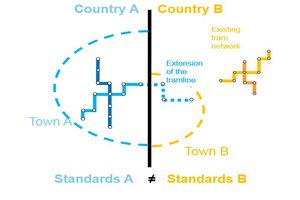News
The proposals of the intergovernmental group on cross-border obstacles
March 2017
On 16 February 2017 in Brussels, the fourth meeting of the intergovernmental working group on innovative solutions to obstacles to cross-border cooperation was held. Noting the benefits of cross-border cooperation, but also the persistence of many obstacles, in 2015 the Luxembourg presidency of the EU Council proposed the development of a new European legal tool, the "European Cross-Border Convention" (ECBC); for its part, the European Commission launched the "Cross-Border Review".
In May 2016 in Amsterdam, the directors-general for territorial cohesion gave a mandate to a working group, co-chaired by Luxembourg and France, and for which the MOT provides the secretariat, to investigate the potential of such a legal tool.
The working group discussed the progress made in terms of listing the obstacles to cooperation, and then the institutional, financial, legal and administrative tools that exist at the European, bi/multilateral and national levels, the inadequacy of which was noted. It then drew up proposals that will be presented to the meeting of directors-general in Malta on 3 April 2017, and communicated to the European Commission. The latter is working on a Communication, which will be published on 6 September 2017.
The Cross-Border Convention would enable a country to apply, in the context of a cross-border project or service of general interest, the domestic law of a neighbouring country within a determined area along the border. It is in no way intended to replace other existing tools, nor to create a new mode of regulation that would make it possible to circumvent ordinary legislative procedure; the objective is rather to put in place a process involving the identification of an obstacle by local players and of a solution, in the form of an ECBC, with the countries concerned being able to accept the solution or to propose a different one (for example an intergovernmental agreement). This process can be illustrated by the example of an extension in a cross-border conurbation of a tramline from Country A to Country B (see illustration). Since domestic standards in these two countries are different, it is proposed to Country B to accept the application of Country A's standards, solely for this specific cross-border tramline.
In each country, the process would be overseen by a national "coordination point" charged with ensuring that the competent authority can rule on the proposed ECBC, and with maintaining a national database, which in turn would be linked to a European database. A multi-level European platform, supplied with information by existing organisations such as the MOT, CESCI and the AEBR, etc., would make it possible to act on each border, foster exchanges between them, assist at national and European levels, and facilitate coordination between countries.
Back to list

